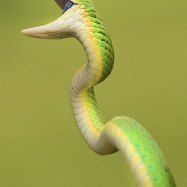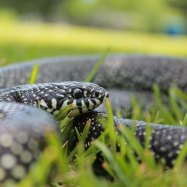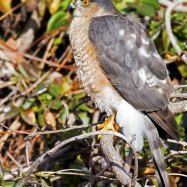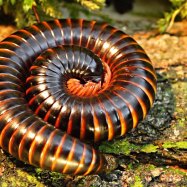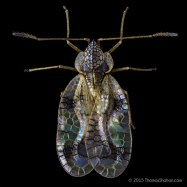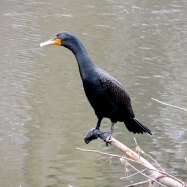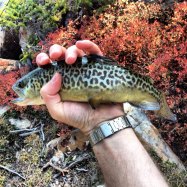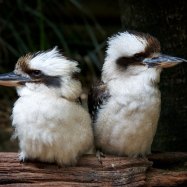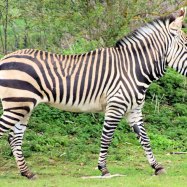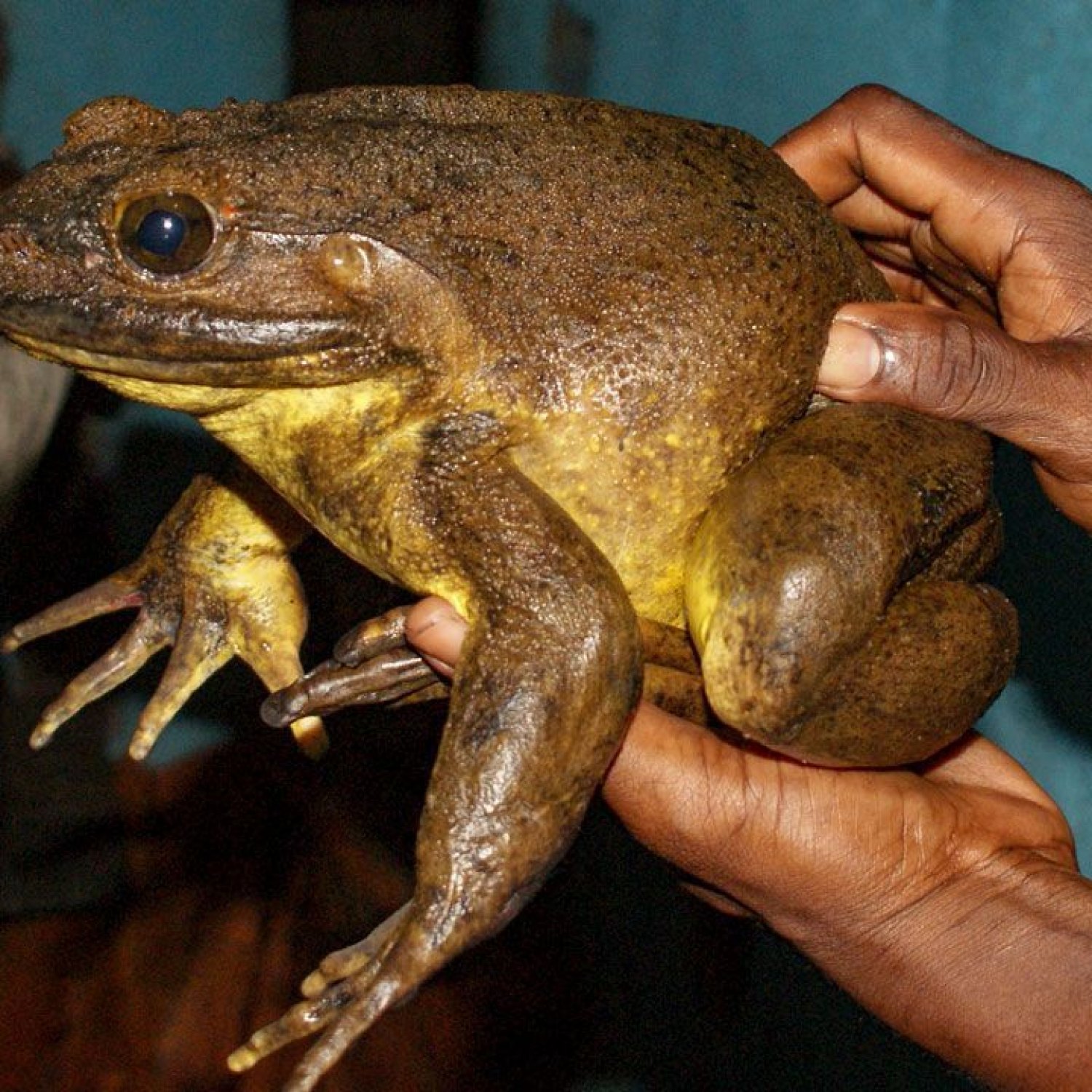
Goliath Frog
30 to 32 cm (11.8 to 12.6 in)
The Goliath frog, found in the rainforests and rivers, is the largest frog in the world. With a length of 30 to 32 cm and a large, robust body shape, it is a sight to behold. Belonging to the family Conrauidae, these unique creatures play an important role in their habitat and are a popular attraction for nature enthusiasts. Keep a lookout for this giant amphibian on your next rainforest adventure! #GoliathFrog #RainforestAnimals #Conrauidae
Animal Details Summary:
Common Name: Goliath Frog
Kingdom: Animalia
Habitat: Freshwater
The Goliath Frog: A Natural Wonder of Africa
In the lush rainforests and winding rivers of West and Central Africa, an unlikely creature stands out amongst its surroundings. With its massive size and unique characteristics, the Goliath Frog, also known as Conraua goliath in the scientific community, has captured the attention and curiosity of both scientists and nature enthusiasts alike.Known as the world's largest frog, the Goliath Frog has a commanding presence and holds a special place in the hearts of those who encounter it. In this article, we will dive deep into the fascinating life of this amazing amphibian, exploring its habitat, behavior, and what makes it truly special Goliath Frog.
The Anatomy of the Goliath Frog
As its name suggests, the Goliath Frog is an impressive and colossal creature. It can reach lengths of up to 32 centimeters (12.6 inches) and weigh up to 3.3 kilograms (7.3 pounds). This size puts them in the same category as small cats and chihuahuas, making them a truly gigantic member of the amphibian family.
The Goliath Frog's body has adapted to its environment, with a unique mottled green and brown coloration that allows it to blend seamlessly with the rainforest foliage. This camouflage is crucial for its survival as it helps it to hide from predators such as snakes, crocodiles, and birds of prey.
In addition to its coloration, the Goliath Frog has a robust and muscular body that allows it to leap great distances and climb over obstacles in its path Giant Armadillo. Its strong hind legs make up about 60% of its body, and its large feet have powerful webbing that helps it to swim and move easily through the water.
The Goliath Frog's Home: Habitat and Distribution
The Goliath Frog is native to the equatorial countries of Equatorial Guinea and Cameroon in West and Central Africa. They can also be found in surrounding countries such as Nigeria, Gabon, and the Democratic Republic of Congo. These frogs are semi-aquatic, meaning they can live both on land and in the water.
Their preferred habitats are freshwater sources, including fast-flowing streams, rivers, and lakes within the rainforest. They can also be found in forest pools and ponds, especially during the breeding season. These habitats provide the Goliath Frog with an abundant supply of food and shelter.
Unfortunately, the Goliath Frog's population is rapidly declining due to habitat loss and degradation. Deforestation and pollution are major threats to the survival of these frogs, as they heavily rely on pristine rainforest environments for their survival. Conservation efforts are in place to protect and preserve their habitats, but the Goliath Frog remains an endangered species.
A Carnivore's Diet
Although the Goliath Frog may seem like a gentle giant, it is a carnivorous predator. These frogs have a powerful jaw filled with small, sharp teeth that they use to catch and consume their prey. Their diet mainly consists of small invertebrates such as insects, snails, and even small vertebrates like fish and other frogs.
Unlike most frogs, the Goliath Frog does not have a long, sticky tongue to catch its prey. Instead, it uses its powerful jaws to grab its prey in a quick and forceful manner. Its predator status may seem surprising, but it is a vital part of the ecosystem, helping to keep its habitat in balance.
The Goliath Frog's Life Cycle
The Goliath Frog's life cycle begins in the water, where it lays its eggs. These eggs are laid in a foam nest created by the female frog to protect them from predators. The male frog guards this nest until the tadpoles hatch.
The tadpoles go through several stages of development in the water, feeding on algae and detritus. As they grow, they develop hind legs first and then front legs, eventually forming into froglets.
Once they are fully developed, these froglets leave the water and begin their life on land. They reach sexual maturity at around 3 to 4 years of age, and their lifespan is estimated to be 15 to 20 years in the wild.
The Goliath Frog's Importance to African Culture
The Goliath Frog is not only an essential member of the African ecosystem, but it also holds significant cultural significance in the countries where it is found. In Cameroon, it is considered a symbol of fertility and prosperity, and the local people believe that seeing a Goliath Frog is a sign of good luck.
In some areas, these frogs are also considered a delicacy and are captured and eaten by the local people. However, due to their declining population, the hunting and consumption of Goliath Frogs are now regulated to ensure their survival.
The Future of the Goliath Frog
The Goliath Frog's impressive size and unique characteristics make it a captivating animal to observe and study. However, it is also a vulnerable and endangered species, facing numerous threats to its survival.
Conservation efforts are underway to protect their habitats, discourage the hunting and consumption of these frogs, and educate the local communities about these incredible creatures. Scientists are also studying their behavior and genetics to better understand how to preserve and protect them for future generations.
One thing is for sure, the Goliath Frog is a crucial species in the ecosystem, and its preservation is key to maintaining the delicate balance of nature in the rainforests of West and Central Africa.
Conclusion
In conclusion, the Goliath Frog is a fascinating and unique creature that calls the rainforests of Africa its home. Its impressive size, vivid coloration, and important role in the ecosystem make it a natural wonder worth protecting.
As we continue to learn more about the Goliath Frog and its behavior, it is essential to remember the importance of conservation and preservation to ensure the survival of this magnificent amphibian for generations to come. Let us all do our part in protecting the Goliath Frog and the diverse and delicate ecosystems it inhabits.

Goliath Frog
Animal Details Goliath Frog - Scientific Name: Conraua goliath
- Category: Animals G
- Scientific Name: Conraua goliath
- Common Name: Goliath Frog
- Kingdom: Animalia
- Phylum: Chordata
- Class: Amphibia
- Order: Anura
- Family: Conrauidae
- Habitat: Freshwater
- Feeding Method: Carnivorous
- Geographical Distribution: West and Central Africa
- Country of Origin: Equatorial Guinea and Cameroon
- Location: Rainforests and rivers
- Animal Coloration: Mottled green and brown
- Body Shape: Large and robust
- Length: 30 to 32 cm (11.8 to 12.6 in)
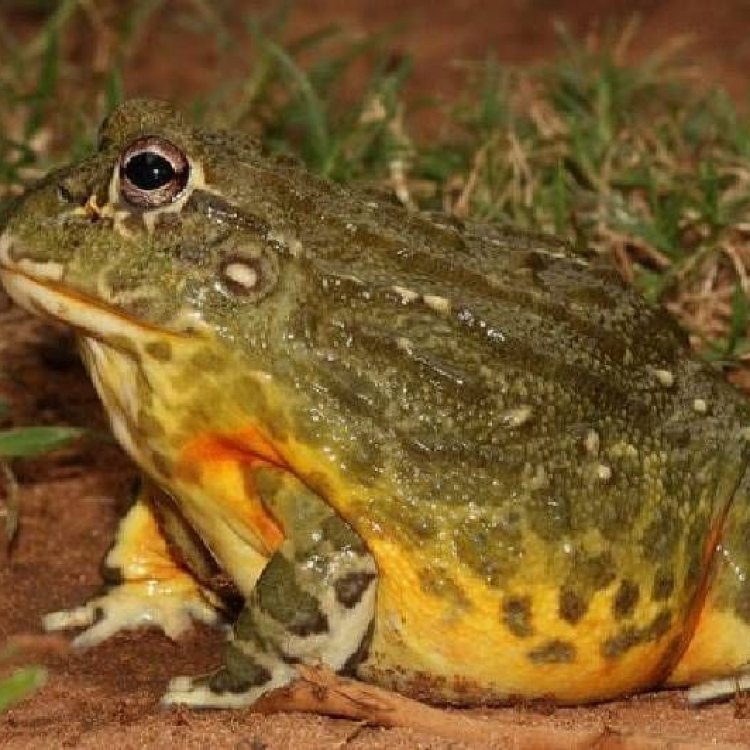
Goliath Frog
- Adult Size: Up to 3 kg (6.6 lb)
- Average Lifespan: Up to 15 years in the wild
- Reproduction: Egg-laying
- Reproductive Behavior: Male defends territory and calls to attract females
- Sound or Call: Loud mating calls
- Migration Pattern: No regular migrations
- Social Groups: Solitary
- Behavior: Sits motionless for long periods
- Threats: Habitat loss, human consumption, and invasive species
- Conservation Status: Vulnerable
- Impact on Ecosystem: Ecological indicator species
- Human Use: Used for food and traditional medicine
- Distinctive Features: Extraordinary size and powerful hind legs
- Interesting Facts: World's largest frog species
- Predator: Birds, snakes, and large mammals
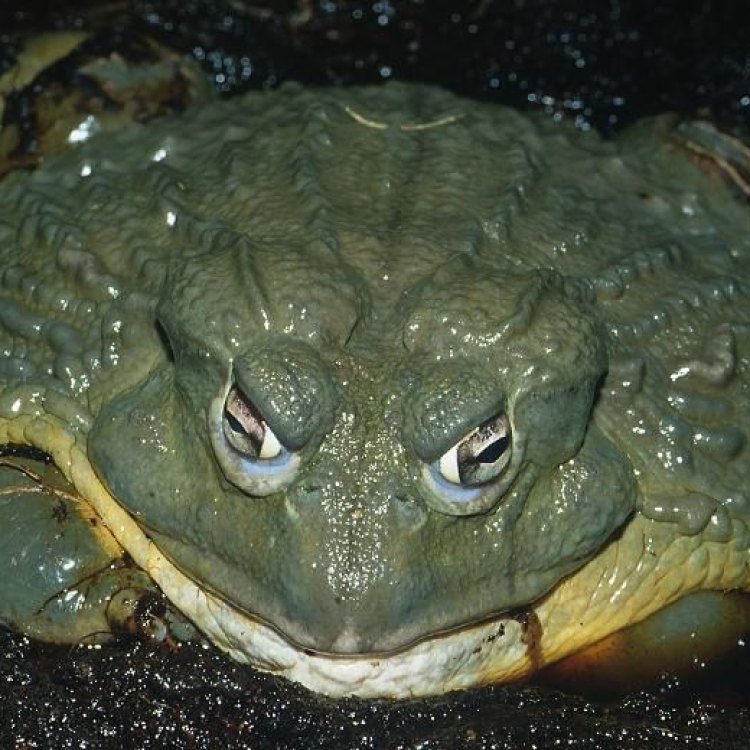
Conraua goliath
The Mighty Goliath Frog: The World's Largest Amphibian
In the dense rainforests of western Africa, there lies an amphibian with an extraordinary size and presence. The Goliath frog (Conraua goliath), also known as the "giant frog" or "goliath bullfrog," is a species that captivates the imagination with its impressively large size and powerful hind legs.The Goliath frog can grow up to 3 kg (6.6 lb) and reach a length of over 1 foot, making it the largest frog in the world PeaceOfAnimals.Com. This massive size is what earned it the name "goliath," after the biblical giant. Its distinctively robust body and powerful hind legs give it an appearance of strength and dominance.
Being the largest frog in the world is not the only remarkable feature of the Goliath frog. This article will delve deeper into the unique characteristics of this fascinating amphibian, from its behavior and habitat to its conservation status and impact on the ecosystem.
A Rare and Vulnerable Species
The Goliath frog is native to the rainforests of Equatorial Guinea and Cameroon, with its range extending to parts of Nigeria and Gabon. These frogs prefer to live in fast-flowing rivers and streams, where they can easily catch their prey and reproduce.Despite being a formidable species, the Goliath frog is listed as "Vulnerable" on the International Union for Conservation of Nature (IUCN) Red List. This means that it is facing a high risk of extinction in the wild due to various threats.
The Impact on Ecosystem
As an ecological indicator species, the Goliath frog plays a crucial role in its habitat Golden Saint. These frogs feed on a variety of insects, fish, and crustaceans, making them key predators in their ecosystem. This means that any changes in their population can have a significant impact on the balance of the ecosystem.Moreover, the Goliath frog is very sensitive to water pollution, and its population decline can serve as an indicator of the health of the water bodies it inhabits. In this way, the Goliath frog helps scientists and researchers monitor the overall health of the ecosystem.
A Solitary and Motionless Creature
Unlike most frog species, the Goliath frog is solitary, meaning it prefers to live alone and does not form social groups or communities. This could be due to its large size, as it would require a lot of resources and space to support a group.Another unique behavior of the Goliath frog is its tendency to sit motionless for hours, often disguising itself among rocks or near the bottom of the riverbed. This behavior helps it avoid detection by predators and makes it a patient and stealthy hunter. However, this also makes them difficult to spot in the wild, adding to their elusive nature.
The Mating Rituals of the Goliath Frog
During the breeding season, male Goliath frogs are highly territorial and will fiercely defend their chosen spot. They also use their large size and powerful hind legs to intimidate and warn off any competing males.To attract females, the male Goliath frog produces loud mating calls that can be heard up to half a mile away. These calls are considered one of the loudest in the animal kingdom and can reach up to 100 decibels, which is as loud as a chainsaw! This unique feature of the Goliath frog is what gave it the nickname "giant bullfrog."
Interesting Facts and Human Use
Apart from its size and behavior, the Goliath frog has many interesting facts that make it a unique and valuable species. These frogs are known to have a lifespan of up to 15 years in the wild, making them one of the longest-living frog species.Unfortunately, the Goliath frog is facing numerous threats, mainly due to human activities. Habitat loss, caused by deforestation, development projects, and mining, is a significant concern for this species. Additionally, the Goliath frog is hunted for food and traditional medicine, as it is believed to have healing properties.
However, increasing awareness and conservation efforts have led to a decrease in the consumption of Goliath frogs in recent years. In Equatorial Guinea, the Goliath frog is now considered a protected species, and it is illegal to hunt or sell them.
The Distinctive Features of the Goliath Frog
Apart from its extraordinary size, the Goliath frog has other distinctive features that set it apart from other frog species. One of the most prominent features is its powerful hind legs, which allow it to jump up to 10 feet in one leap! This incredible ability makes it easier for the Goliath frog to catch its prey and escape from predators.The Goliath frog also has a unique reproductive behavior, as it is an egg-laying species. This means that females lay eggs, and the males fertilize them externally. The eggs are then left to develop and hatch on their own without any parental care.
Predators and Conservation Efforts
Although the Goliath frog is a large and intimidating species, it still has predators in the wild. Birds, snakes, and large mammals such as monkeys and wildcats are known to prey on these frogs. Humans, too, have been a significant threat to their population, either through direct hunting or habitat destruction.Thankfully, several conservation efforts are in place to protect the Goliath frog and its habitat. These include measures to reduce habitat loss, captive breeding programs, and monitoring of their population and health.
The Wonder of the Goliath Frog
In conclusion, the Goliath frog is a unique and remarkable species that deserves our admiration and protection. With its impressive size, behavior, and contribution to the ecosystem, it stands as a symbol of the natural wonders of our planet. However, its survival is at risk, and it is up to us to take action to ensure that this mighty frog remains a part of our world for generations to come.

The Goliath Frog: A Natural Wonder of Africa
Disclaimer: The content provided is for informational purposes only. We cannot guarantee the accuracy of the information on this page 100%. All information provided here may change without prior notice.

